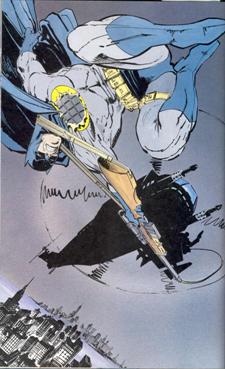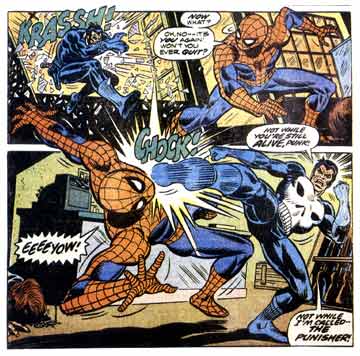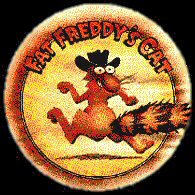|

11/01/06
By Wil Forbis
 Like any youth who seeks to escape the harsh realities of
life by cocooning themselves in a world of fantasy, comics were a big part of
my childhood. As a pre-teen, the highlight of my week was usually a Friday
dinner with my mom at McDonald's followed by a trip to the local used
bookstore, Froggies, which had a vast collection of second hand comics, three
for a dollar. Via that routine I immersed myself in the world of superheroes,
particularly the denizens of the Marvel Universe and slowly amassed a
collection of comics numbering in the thousands. And even after I'd "grown
up" I stayed with the hobby, collecting various underground and
"mature" comic book titles like “Hate,” “Eightball,” “The Killing
Joke” and “The Watchmen.” But while a lot of comic fans switch to adult titles
and then turn their back on their childhood superheroes I have fond memories of
both. Can't crimson clad comic avengers live hand in hand with angst-ridden,
neurotic uber-hipsters? It is my firm belief that they can, and they do in the
boxes of comic books I still have in my closet (right behind the shrunken heads
of various prostitutes.) Thus I'd like to use this article to introduce you to
a few of my favorites: Like any youth who seeks to escape the harsh realities of
life by cocooning themselves in a world of fantasy, comics were a big part of
my childhood. As a pre-teen, the highlight of my week was usually a Friday
dinner with my mom at McDonald's followed by a trip to the local used
bookstore, Froggies, which had a vast collection of second hand comics, three
for a dollar. Via that routine I immersed myself in the world of superheroes,
particularly the denizens of the Marvel Universe and slowly amassed a
collection of comics numbering in the thousands. And even after I'd "grown
up" I stayed with the hobby, collecting various underground and
"mature" comic book titles like “Hate,” “Eightball,” “The Killing
Joke” and “The Watchmen.” But while a lot of comic fans switch to adult titles
and then turn their back on their childhood superheroes I have fond memories of
both. Can't crimson clad comic avengers live hand in hand with angst-ridden,
neurotic uber-hipsters? It is my firm belief that they can, and they do in the
boxes of comic books I still have in my closet (right behind the shrunken heads
of various prostitutes.) Thus I'd like to use this article to introduce you to
a few of my favorites:
The '70s Spider-Man/Jackal run

The Punisher's introduction. |
When I first started collecting comics as a pie-eyed (and
pie eating!) youth in the 80's I became particularly absorbed with a comic
series called Marvel Premier which had taken to reprinting classic Spider-Man
stories from years below. Part of this run included some great soap opera-ish
stories written by Gerry Conway and drawn by the underrated Ross Andru, featuring a
villain called the Jackal. Years before, the love of Peter Parker's life, Gwen
Stacy, had been killed in a battle with a super villain. So when a Gwen Stacy
clone shows up, obviously the reader's curiosity is piqued. Over the course of
a 12 issue run it was revealed that one of Peter's college professors, Miles
Warren had taken tissue samples from his class, including samples from both
Peter Parker and the fetching Miss Stacy (whom, of course, the professor
secretly loved.) Her death had led to
Warren’s
madness and his assumption of the guise of the Jackal, a cackling, green clad
super villain. The storyline also included the introduction of a quasi-hero who
would go onto great success, The Punisher, who is goaded by the Jackal into
trying to assassinate Spider-Man. The final denouement was a killer as
Spider-man faces off with his own clone while the Jackal crowed from the sidelines. There was even a
great epilogue story as Peter struggled to verify whether or not he was the
real Spider-Man, or the clone.
Fat Freddy's Cat
 Up until the late 80's I was a pretty straight comic book
fan. By this I mean I wasn't gay, and I read comics about sweaty muscular men
who dressed up in skin tight costumes and did battle by rolling around
on top of each other. I was completely oblivious to the whole underground comic
book movement that had had its heyday in the '70s and was still trucking
in the works of Harvey Pekar, Robert Crumb and Art Spiegelman. This all changed
when I picked up a copy of Gilbert Shelton's Fat Freddy's Cat Anthology series
at the local comic store. Fat Freddy's cat was a sort of like what
Garfield might have been
had Jim Davis been a pot smoking hippie with a predilection for reading Hunter
S Thompson novels. (Lord knows we all would have been much better off.) Fat
Freddy, the feline's owner, was a particularly inept hippie living in
San Francisco and was a member of another
Shelton creation, the trio known as the Fabulous
Furry Freak Brothers. While the Freak Brothers' comics were straight underground
fare, Fat Freddy's Cat always had a bit of playful innocence to it - plenty
of the jokes were, at their heart, the kind of thing you could find in the
regular Sunday funnies. Of course, the rest of the material focused on the
Cat's predilection for shitting in Fat Freddy's shoes, eating his pot or
drinking his booze. But the best stories revolved around the tall tales the cat
would tell his three Hewey, Dewey, and Louie-esque nephews. (Characters who
were a simultaneous tribute and middle finger to the Disney influence on
American culture.) My favorite involved the Cat in the guise of a secret agent
determined to foil a plot by a nefarious arch-villain attempting to poison
America
's water
supply with a drug that turned everybody queer. The cat fails, blows his brains
out, and then explains to his nephews that he still had eight lives left. Up until the late 80's I was a pretty straight comic book
fan. By this I mean I wasn't gay, and I read comics about sweaty muscular men
who dressed up in skin tight costumes and did battle by rolling around
on top of each other. I was completely oblivious to the whole underground comic
book movement that had had its heyday in the '70s and was still trucking
in the works of Harvey Pekar, Robert Crumb and Art Spiegelman. This all changed
when I picked up a copy of Gilbert Shelton's Fat Freddy's Cat Anthology series
at the local comic store. Fat Freddy's cat was a sort of like what
Garfield might have been
had Jim Davis been a pot smoking hippie with a predilection for reading Hunter
S Thompson novels. (Lord knows we all would have been much better off.) Fat
Freddy, the feline's owner, was a particularly inept hippie living in
San Francisco and was a member of another
Shelton creation, the trio known as the Fabulous
Furry Freak Brothers. While the Freak Brothers' comics were straight underground
fare, Fat Freddy's Cat always had a bit of playful innocence to it - plenty
of the jokes were, at their heart, the kind of thing you could find in the
regular Sunday funnies. Of course, the rest of the material focused on the
Cat's predilection for shitting in Fat Freddy's shoes, eating his pot or
drinking his booze. But the best stories revolved around the tall tales the cat
would tell his three Hewey, Dewey, and Louie-esque nephews. (Characters who
were a simultaneous tribute and middle finger to the Disney influence on
American culture.) My favorite involved the Cat in the guise of a secret agent
determined to foil a plot by a nefarious arch-villain attempting to poison
America
's water
supply with a drug that turned everybody queer. The cat fails, blows his brains
out, and then explains to his nephews that he still had eight lives left.
The Teen Titans/Terra run
For most of my teen years, Marvel Comics had a clear lead
over DC in terms of sales and general popularity. That started to change when
former Marvel staffer Marv Wolfman switched companies to work on DC's Teen
Titans, a title about a superhero team comprised of many of the comic sidekicks
of DC's A-List heroes. Bat-Man's Robin joined forces with Kid-Flash, Wonder
Girl and several other accessory characters to battle crime and injustice. The
writing was much hipper than DC had been known for and suddenly the company
found their "X-Men."
But the series really kicked into high gear with a multi
issue story arch that involved the Titan's arch nemesis, the Terminator,
planting a spy in their midst. This super-powered Mata Hari was Terra, an
earth-moving blonde teenager who was, on the side, the Terminator's lover.
Wolfman played the story off brilliantly, carrying it over several years until
a climactic four-issue final where Terra’s deceptions were revealed and she and
the Terminator did battle with the Teen Titans. The excitement with which I
anticipated the final issue was equal to that created while waiting for a new
Star Wars film - it was that good!
Lout Rampage (The Eightball Collection)
By the early nineties, I had pretty much tired of
superheroes and was burnt on comics in general. As mentioned in this article's
predecessor, “Movies that Made Me Shit my
Pants,” I was also flat broke and spent a lot of time entertaining myself
at the Seattle Public Library. It was there I discovered Lout Rampage, a
collection of comic stories drawn from Dan Clowes Eightball comic book. (Most
famous for running the stories that inspired the movie "Ghost World.") In Lout Rampage I found comics as
I'd never seen before, comics that seemed to speak directly to the social
revolution brought about by the grunge era that was exploding around me and
creating a world where one's social status could be shredded if it were
revealed they didn't know the b-side of some obscure single released by a
garage band in 1967. Clowes brilliantly criticized trendy hipsters who wanted
both underground status and mass recognition, and also offered up hilarious
satires of Richie Rich comics, Chick
publication's religious tracks, and the self-absorption of the '80s. I read
and re-read Lout Rampage and eagerly collected Clowes’ Eightball comics which I
hold up as the greatest comic series ever.
The Watchmen

Rorschach defies psychoanalysis |
I contemplated not adding Alan Moore's spectacular 12 part
comic book series, "The Watchmen" to this list of comics that made me
shit my pants because it's been well discussed in the realm of egghead literary
types who tend to dismiss most comic books as juvenile distractions. But even
though The Watchman has earned accolades from a class of people I despise,
there's no getting around it a great piece of work. In the late '80s DC Comics
purchased the rights to the characters that had been owned by the little read Charlton comic book company.
The original concept for The Watchmen comic series was to take these characters
and insert them into a uber-realistic alternate reality where Nixon was still
President and the
United
States
reined supreme because the government
had co-opted the services of it's most powerful superheroes. For various reasons,
the Charlton characters were dropped and all new characters were created. Among
them were the Comedian, a cynical, murderous mercenary, Dr. Manhattan, a living
weapon of mass destruction who was no longer bound by the laws of time and
space, and Rorschach, a street-wise vigilante who saw raw brutality as the only
way to stop the criminal element.
Moore
weaved all these characters into a complex spider web of a story that holds up
to repeated readings.
Wendy Whitebread: Undercover Slut
 I still recall the day in the early 1990s when my good friend Neslo handed over a copy of the infamous, hardcore porn comic book "Wendy Whitebread, Undercover Slut" for my perusal. As I viewed its semen stained* and lovingly rendered pages I realized I was looking at a comic book like no other. Within its covers, artist/author Anton Drek told the story of prudish Wendy Whitebread, an up and coming police officer assigned the task of posing as a prostitute for the Vice Squad. The Squad's prime mission is taking down down the infernal "Mr. Misogyny," an uncatchable lout intent on graphically denigrating the various women he "comes across." (As Wendy keenly observes in one of the comic's many bits of comic dialogue, "Goodness. Mr. Misogyny doesn't think very highly of women!") Wendy leads her team of the clothing-deficient "Untouchables" to track down their arch-villain while having sex with a whole lot of other guys along the way. And no one was more shocked than I to discover (SPOILER ALERT) that Mr. Misogyny is actually Wendy's true love, Officer Paul Pureheart. I still recall the day in the early 1990s when my good friend Neslo handed over a copy of the infamous, hardcore porn comic book "Wendy Whitebread, Undercover Slut" for my perusal. As I viewed its semen stained* and lovingly rendered pages I realized I was looking at a comic book like no other. Within its covers, artist/author Anton Drek told the story of prudish Wendy Whitebread, an up and coming police officer assigned the task of posing as a prostitute for the Vice Squad. The Squad's prime mission is taking down down the infernal "Mr. Misogyny," an uncatchable lout intent on graphically denigrating the various women he "comes across." (As Wendy keenly observes in one of the comic's many bits of comic dialogue, "Goodness. Mr. Misogyny doesn't think very highly of women!") Wendy leads her team of the clothing-deficient "Untouchables" to track down their arch-villain while having sex with a whole lot of other guys along the way. And no one was more shocked than I to discover (SPOILER ALERT) that Mr. Misogyny is actually Wendy's true love, Officer Paul Pureheart.
Neslo actually offered to gift me his copy of WW but for reasons that escape me I turned him down and it was years later that I got my own copy from the comic store I lived above in Seattle. (I still remember the look of searing disdain given to me by
the female, 60-ish cashier when I purchased it.) And it was around that time Anton Drek was revealed to be Don Simpson, creator of the popular "Megaton Man" independent comic. (Though WW is noted as the most popular periodical he ever wrote.) "Wendy Whitebread, Undercover Slut" has since become a cult fav and I treasure my well read copy as much as life itself.
* Er, that's cartoon semen I'm talking about, not the result of Neslo's late night activities.
The Dark Knight Returns
Complimenting "The Watchmen" as one of the great
reinventions of the superhero genre was 1986's "The Dark Knight." In
a four part mini series, comic book renegade Frank Miller re-imagined Bat-Man
(and many other characters of the DC Comic's universe) in a gritty, violent,
Blade Runner-ish future. Bat-Man, now in his 50's and looking reminiscent of
Marlon Brando in "Last Tango in
Paris",
comes out of retirement to re-engage the criminal element that has taken over
everything from the streets of
Gotham
City to the U.S.
Government. Slickly packaged and elegantly rendered, "The Dark
Knight" shattered the conventions of what superhero comics were about and
cast an influence that lasts too this day. Sadly, the follow up series that ran
in early 2002 never held my interest and I stopped buying them after a few
issues.
What do you think? Leave your comments on the Guestbook!
|
 |
|


